News & Case Studies
- Details
- Written by Administrator
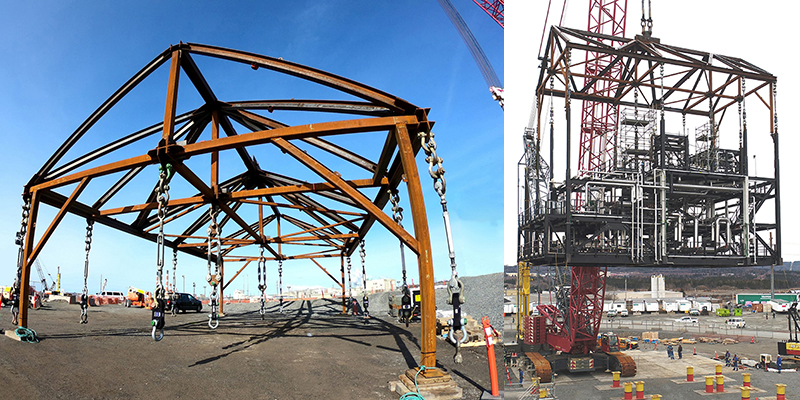
A dozen wireless Straightpoint (SP) load cells were added to a custom-built lifting frame that utilized 12 pick points to raise a pair of non-identical refinery modules at a major brownfield project at Saint John in New Brunswick, Canada recently.
The 100-tonne capacity Radiolink plus dynamometers were provided by Stoney Creek, Ontario-based Equipment Corps Inc., which delivered the load monitoring solution to Irving Equipment, headquartered in Saint John. The latter also provided the Demag CC2800 crawler crane, equipped with a superlift. The equipment combined to complete a key phase of the oil refinery project, where a new processing unit was being installed.
Once Irving had designed and fabricated the customized lifting frame, based on the refinery’s specifications, it needed a method of monitoring the loads so they could be certain that the forces generated during the lift did not exceed the design criteria; the modules had extremely tight deflection tolerances that had to be adhered to. Further, explained Irving’s Ryan Long, the height of rigging had to be kept to a minimum due to the weight of the lifts and to avoid the need for a larger crane. The frame was designed to pin directly to the hook of the Demag.
Long added: “The module was designed by the time we were introduced to the lift so deciding where the pick points should be located was a challenge. We needed to find a way to safely lift the modules, whilst conforming to the pick points that were available, which turned out to be three rows of four, including a center row, which made traditional frames and spreader beams prohibitive. Both [modules] had identical lifting points but different weights and centers of gravity. Each pick point was directly above a steel supporting column in the module and the structural design limitations of those columns differed.”
Under the frame were a total of 82 55-ton shackles, 14 Crosby 2.75” turnbuckles, and four equalizer plates, in addition to the load cells. Long explained that a turnbuckle is a piece of rigging gear traditionally used in tensioning applications. They are adjustable in length by means of turning a center body around opposing screws. They are most commonly associated with utility pole guy-wires, he added.
Luke Habza, of Equipment Corps, added: “After taking a light pull with the crane, the team was first able to determine if the load ratios were approximately correct on each pick point. After adjustments were made to the turnbuckles based on the real-time readout on the tablet [utilizing SP’s SW-MWLC high-speed wireless data-logging software] the lift director was able to signal the crane to take incrementally larger loads until the module was airborne and the load of each pick point was known with confidence.”
Each module had been transported from a barge by Irving using 36 axle lines of self-propelled modular transporters (SPMT). Equipment Corps then placed them onto supporting stools whilst the site made final preparations. The modules were transported approximately 2.5km on land and barged another 20km prior to being landed on those stools. Irving used a team of six people for the transportation and four people to execute the lift.
- Details
- Written by Administrator
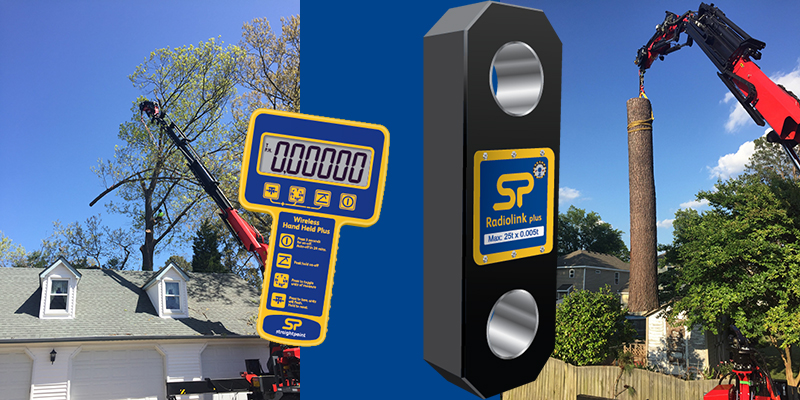
A Straightpoint load cell was used during the felling of nine hulking loblolly pine trees at a residential property in Chesapeake, Virginia, recently—one of which had been struck by lightning.
The wireless 25,000-lb. capacity Radiolink plus was utilised by arborist Adaptable Aerial Solutions LLC, beneath the hook of its Palfinger knuckle-boom crane, principally to avoid exceeding the safe working load limit of the company’s ropes and rigging hardware and compromising the structure of the tree in relation to dynamic forces and critical angles.
Four Adaptable (or Craneva, as it is known after the website name) arborists worked at heights of up to 90 ft. to bring down the trees in a piecemeal fashion; branches were removed first then the trunks. The team employed spliced eye balancing slings and endless loop slings. The balancers were tied with a non-binding hitch and the roundslings were set in a choker configuration using shackles and hooks for attachment at the choking point to prevent fabric on fabric friction.
Wood weights were calculated in advance using a green weight log chart that provides a general guideline by species and size. On-site, the load cell recorded the smallest pick at 1,625 lbs. and the largest at 6,500 lbs.
Steve Connally, of Adaptable Aerial Solutions, said: “The crane doesn’t have an LMI [load moment indicator] like a cable crane. The controller shows the percentage of load on a LED light cluster. Since the wood weight varies considerably with environmental factors, time of year, and the number of branch unions, it’s necessary to know the weights of the picks in relation to the load chart and strength of rigging components. Each lift weight is evaluated in relation to the previous lift and the following. It’s a continuous harmony between the crane operator and the climber. This ensures we stay working within safe parameters.”
He added: “I am very impressed with the load cell. It is perfect for my application in weight, design, and ease of use. The data from the [load] cell allows me to pretension picks as the climber is cutting. As with any industrial lift evolution, weights, angles, and distances are essential information. Services I sub-contract for have been equally impressed with the Radiolink plus.”
Crane expertise
The 50 ton meter, remote-controlled, articulating crane offers anywhere from 1,440 lbs. to 22,700 lbs. on capacity, depending where it is on its load chart. Connally is a National Commission for the Certification of Crane Operators (NCCCO) certified crane operator and has been using cranes in arboreal applications for 20 years.
Additionally, he and the team are fully trained in arborist rigging and technical rescue rigging operations. Connally is also an instructor at the Crane Safety Climber School, a class for arborists working with cranes for tree work. He explained that educational content includes hands-on training where a climber is aloft and performing rigging with an instructor alongside them in the tree.
Connally explained that tree felling is more complicated than many realize; it simply isn’t a case of heading to the foot of one with a chainsaw or an axe. He said: “Trunks are taken, when possible, at lengths to fit specifications of the saw mills or pulp producers. It’s typically depending on the potential hazards on the ground, ease of processing, quickest method, and the available workspace—not to mention customers who want to maintain a perfect lawn. These trees were all on the property line; we had to ensure that power lines, pools, fences, structures, and understory was unharmed.”
Interestingly, Connally is also a 22-year veteran firefighter with the city of Norfolk Virginia and has been a paramedic for 27 years. For 10 years he was a member then a supervisor of the hazardous materials and technical rescue teams.
- Details
- Written by Administrator
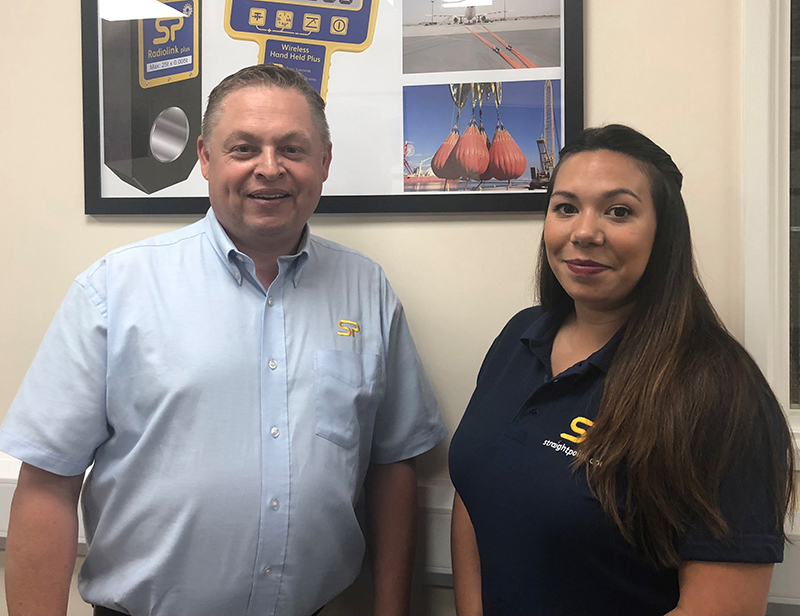
Straightpoint (SP) has appointed Kizzie Cordwell to the role of inside sales, as the load cell manufacturer continues to grow its team at Havant headquarters in the UK.
Cordwell brings a wealth of experience to the position, having previously worked in sales and customer service roles. Most recently, she worked in the construction sector selling heavy-duty machinery such as diggers and wheeled loaders.
Cordwell said: “The position was recommended to me by a current employee at the company, so I was aware of the ethos of the business, which seemed to fit well with my own approach to working practices and ambitions. I enjoyed my previous role but the timing of the opening at SP was good and I’m excited to be given the opportunity.”
David Ayling, director at Straightpoint, said: “As I’ve said before, we always look for certain DNA traits when searching for personnel to join our team. We had 18 strong applications for the recently vacated position and Kizzie was the standout candidate; we’re all excited about working with her in the immediate and long-term future.”
In her previous position, in addition to the aforementioned core areas of responsibility, Cordwell was also charged with overseeing workshop workloads and was the designated person for troubleshooting in a number of departments. In a multifaceted role, she also oversaw production of marketing materials, media releases, and managed social media. It is a diverse skillset she’s looking forward to leveraging at SP.
She explained: “Essentially, my new role involves working with customers, primarily on the telephone and over email, to generate quotes and maximise the sales of the business. However, I am confident that the position will diversify over time and there will be great opportunities for career development. In my early days here I’ve detected a relaxed culture where staff are encouraged to express themselves and put their ideas forward for discussion.”
Cordwell continued: “SP is a growing business but it’s clear they haven’t lost that all-important personal touch and they clearly care about their customers. It’s evident already that David and the team work hard to preserve a supportive culture and everyone has been very welcoming. I’m picking up the systems and am gradually learning the vast array of products we can provide. Of course the task of learning them all is slightly daunting but I intend to tackle that challenge head-on.”
Ayling concluded: “It’s easy to forget the extent of the diversification of the SP range, which now serves so many niche industries and applications, but all our innovation and expansion stems from the same core set of values and Kizzie has already shown a great aptitude to that culture so the learning curve will be that much smoother.”
- Details
- Written by Administrator
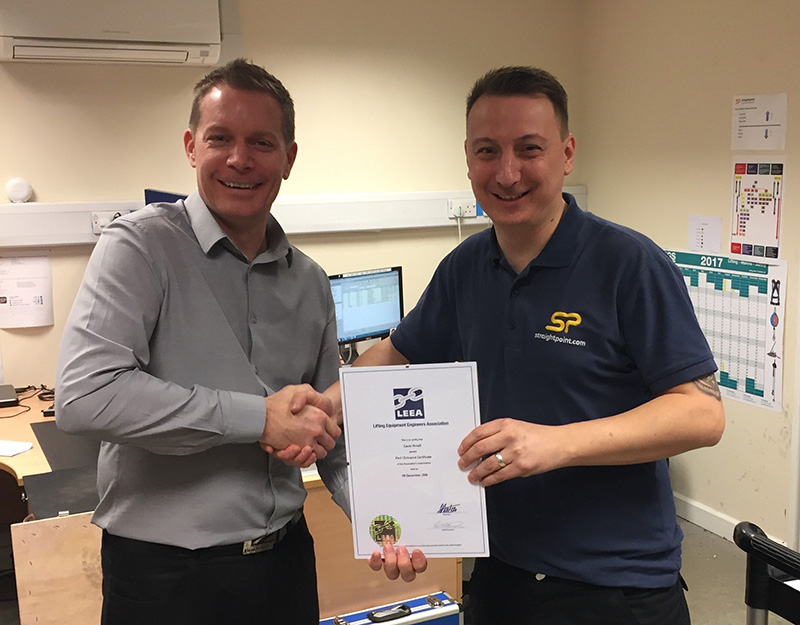
Straightpoint (SP) has been granted full membership in LEEA, reaffirming its status as a lifting equipment business versus a load cell manufacturer that has diversified into the sector.
The Lifting Equipment Engineers Association is the world’s leading representative body for all those involved in the industry. To become a full member, a company must be engaged for profit in the verification of lifting equipment and, in the opinion of the directors, is competent and can give an adequate service.
David Ayling, director at SP, said: “We see ourselves as a lifting equipment company first, not just a load cell business, thus, it was natural for us to covet full LEEA membership. Its tagline is ‘lifting standards worldwide’, while we define our purpose as ‘making the lifting industry a safer place’, so without placing undue emphasis on the synergy, we are kindred spirits.”
SP was previously a development member, which is a precursor to full membership but one that is not transcended as a formality. Companies must pass a rigorous audit and meet the highest standards of the association, the respected and authoritative representative body for members who work in every aspect of the industry, from design, manufacture, refurbishment and repair, through to the hire, maintenance and use of lifting equipment.
Further, full members must have a company-approved examiner, which at SP is Gavin Arnell, product technician, who has taken both the association’s P1E Foundation Course and Lifting Equipment General (LEG) Advanced Programme. The former includes 28 modules covering a range of subjects from standards and codes of practice to wire rope and types of cranes; it is a prerequisite for studying at advanced level. The advanced course offers hands-on practical training to complement essential theory sessions. Content is based on lifting accessories and includes thorough examination procedures and criteria for continued periods of service.
Alfie Lee, operations director at SP, said: “We are grateful for the guidance, support, and thoroughness of our contact at LEEA, Bernie Winter [technical officer], who took us through the process. We look forward to hosting Bernie and other representatives of the association as they conduct subsequent audits and hold us to their industry benchmark standards.”
Ayling concluded: “Alfie and Gavin have played key roles in achieving this widely sought after status within LEEA, but it is recognition that the entire SP operation adheres to its protocols and we look forward to leveraging the commercial and other opportunities full membership creates in the myriad of marketplaces that apply lifting equipment.”
- Details
- Written by Administrator
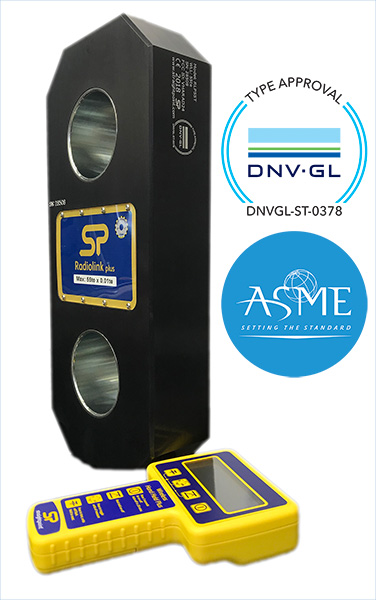 Straightpoint (SP) has made a series of enhancements to its range of loadlink products that includes matching the capacity of its previous 5t and 50t capacity units to industry standard shackle sizes of 6.5t and 55t respectively.
Straightpoint (SP) has made a series of enhancements to its range of loadlink products that includes matching the capacity of its previous 5t and 50t capacity units to industry standard shackle sizes of 6.5t and 55t respectively.
SP manufactures the Loadlink plus digital tension load cell, or dynamometer, but the word ‘loadlink’ is used generically, also in reference to the company’s best-selling Radiolink plus and Wirelink plus products. David Ayling, director at SP, explained that the terminology is widely applied throughout the lifting and other industries to describe tensile links that are rigged using shackles.
He added: “The previous sizes were based on an incremental capacity scale that was adopted by the company even years before my arrival. We stuck with what the customers were already familiar with for good reason and at great success; however, we were increasingly quizzed on why the range didn’t align with, say, the Crosby, Green Pin, or GN Rope lines of shackles.”
Ayling acknowledged that a further catalyst for change was the DNV GL Type Approval Certification process; as a result of which the three aforementioned products now comply with DNVGL-ST-0378, the standard for offshore and platform lifting appliances. An 18-month programme involved the entire SP community, from in-house engineers to end users, and a proposed move to conformity with industry standard shackle sizes, albeit unrelated to DNV, was given overwhelming backing by relevant stakeholders.
In addition, SP has also increased the capacity of the loadlink range to 500t (up from 300t), while the lowest unit remains 1t. It is recommended that users only apply the products down to 3% of their working load limit (WLL), so a 100t capacity Radiolink plus, for example, can be safely applied to a 3t load test.
A final improvement has been made to smaller loadlink models to improve their waterproof sealing, giving offshore and other purchasing decision makers even greater confidence in the load cells’ performance. Ayling explained that the cavity in which the chassis and front plate fits into was the focal point of this particular enhancement.
He concluded: “Matching up with the industry’s shackles and adding even more differentiating factors to the loadlink range was a rewarding but painstaking process. Replacing the 5t and 50t units involved a complete redesign of the products, FEA [finite element analysis], extensive testing, and more before we could put this popular evolution to market.”





